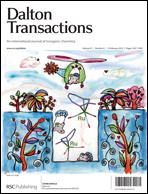Five Fe(III)Mn(III) bimetallic compounds [Fe(iqc)(CN)3][Mn(5-Xsalen)]·pMeOH·qMeCN·rH2O [Hiqc = N-(quinolin-8-yl)isoquinoline-1-carboxamide; salen = N,N′-ethylenebis(salicylideneiminato) dianion; X = H(2), F(3, 3a), Cl(4), Br(5)] were prepared by assembling a newly designed mer-Fe tricyanide (Ph4P)[Fe(iqc)(CN)3]·0.5H2O (1) and the respective Mn Schiff bases Mn(5-Xsalen)+. Compounds 2–4 show linear chain structures in which trans-positioned cyanides of the Fe precursor bridge neighbouring Mn atoms, while 5 is a zigzag chain coordination polymer where two cyanide groups of the precursor in the cis mode act as bridges. The structural change from linear to zigzag may arise from the size effect of the halogens. The reversible structural transformation occurs between 3 and 3a upon the solvation-desolvation protocol and the corresponding magnetic behaviours are affected. Furthermore, in 4 and 5, the helical chains are established through hydrogen bonding of solvent molecules. From a magnetostructural point of view, within the linear chain system, the ferromagnetic coupling in 2, contrary to antiferromagnetic interactions in 3–4, is associated with the large torsion angle of Ceq–Fe–Mn–N(O)eq (eq = equatorial) as well as almost the linear Mn–N![[triple bond, length as m-dash]](https://www.rsc.org/images/entities/char_e002.gif) C angle.
C angle.

You have access to this article
 Please wait while we load your content...
Something went wrong. Try again?
Please wait while we load your content...
Something went wrong. Try again?
![[triple bond, length as m-dash]](https://www.rsc.org/images/entities/char_e002.gif) C angle.
C angle.

 Please wait while we load your content...
Please wait while we load your content...